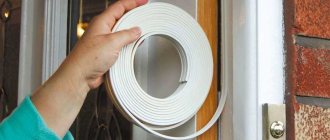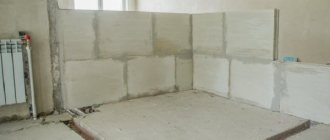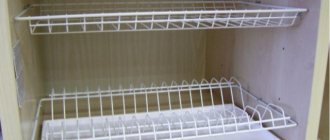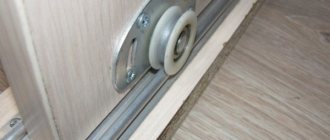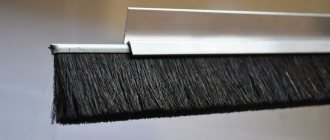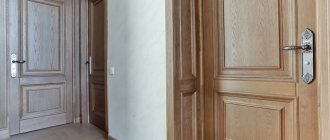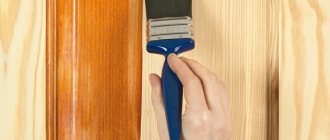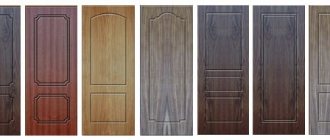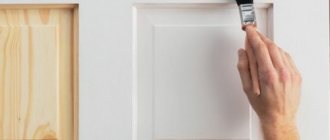To prevent a metal door from letting in cold air and noise from outside the room, it must have a seal on it. This rather simple but very important fitting becomes unusable over time and therefore requires periodic replacement. When purchasing it and installing it yourself, it is necessary to take into account certain nuances, then the product will perform all the functions assigned to it. Next, let's look at what a seal for iron entrance doors is, how to choose and install it correctly.
Seals for entrance doors and interior structures: types, selection and installation
Seals for entrance doors prevent noise and cold air from entering the room from the street. This article will help you understand the existing types of products, which differ in configuration, material of manufacture, size, purpose and installation technology. Here you can find tips on how to choose the appropriate type of seal and install it correctly on the door. Seals for windows: types, characteristics and design features (read more)
Sealing tapes are used to seal doorways.
Foam rubber and polyurethane types
Foam tape is the most affordable, simplest option. The presence of a self-adhesive base allows you to insulate the doorway in a short time, without the need to make any effort or have additional material. It can also be secured with small nails if the surface is made of wood. Foam rubber is a good protection, but its fragile structure does not allow it to withstand difficult operating conditions; it is negatively affected by: humidity, dirt, temperature changes.
Gradually it becomes unusable, shrinks, crushes, crumbles. Most often, foam rubber tape is used as a seal for interior doors.
A type of door seal is a polyurethane product, which, thanks to the self-adhesive film on one side, is easily fixed to the door. Its area of application includes wooden doors. Metal structures quickly damage the product, as a result of which the heat-protective qualities decrease.
Seals for entrance doors: features and advantages of use
A seal for a metal entrance door is a flexible product in the form of a small strip or tube. It is installed in the gap between the door leaf and the frame around the entire perimeter. Thanks to its easy and simple fixation, the material has a wide range of applications. It applies to pasting window frames, interior doors, compartment-type cabinets, and vents. With a high-quality seal, the front door takes on a finished look. This product eliminates a large number of shortcomings in its design.
All rubber seals differ in type and installation method.
The material is universal because it can perform several functions simultaneously:
- protects interiors from drafts;
- prevents the penetration of dust and odors from the outside;
- ensures the tightness of the structure;
- used as door insulation;
- provides sound insulation;
- dampens the door leaf, reducing the noise level when closing.
On a note! The insulation is able to compensate for minor defects in the door leaf, for example, small errors in size, bends of sheet metal, providing a more comfortable and tight closure.
Main requirements
To insulate the front door, it is permissible to use only certain types of materials. First of all, you need to find out what requirements the seal must meet. Main provisions:
- tightness of the structure;
- soundproofing;
- thermal insulation;
- soft closing of the sash;
- wear resistance, resistance to temperature changes;
- ensuring fire safety;
- elasticity.
Necessary parameters for seals
Human nature is such that each of us tries to provide ourselves with comfort, but at the same time spend a minimum of effort. This applies to everything, and insulation in this case is no exception. Why suffer from drafts from a window or door when you can install a seal and forget about this problem altogether?
So, the main parameters that the seal meets
- Speed and ease of gluing - the whole process will take 15 minutes at most, and will be enough not only for this winter, but also for the next 3-4.
- Isolation of odors, dust and sounds - seals allow you to get rid of all negative factors.
- A rubber or silicone seal provides the door with good shock absorption when closing/opening.
- The entire structure should not vibrate due to the presence of play.
- During closing/opening there should be no sharp sounds from the contact of metal parts of the door.
- At sub-zero temperatures, seals must remain elastic and not harden, otherwise cracks will appear through which air will blow again.
On request, it is possible to manufacture seals of all profiles in any colors and sizes
This is interesting: How to loosen a door closer
Thermal Insulation Benefits of Door Gaskets
The main purpose of door seals is to eliminate gaps and cracks, preventing wind and cold air from entering the room. This is an indispensable attribute of structures in a private house facing directly onto the street.
If the door is made of wood, it will react sensitively to dampness and moisture during the rainy season. During the hot season, the material is susceptible to drying out. Under such conditions, the door frame is greatly deformed and the tightness of the door leaf is lost. You can replace the structure with a new one, but such an undertaking will cost a pretty penny. There is a budget option for solving this problem - using a seal, which can be easily and quickly replaced if necessary. It will retain heat in the room and extend the life of the door structure.
Door seals provide additional thermal insulation.
As a door insulator, the gasket acts on both sides: it limits the entry of cold air from the street and retains heat from the inside. If the design does not have a seal, then the efficiency of heating devices is reduced by 40%. That's how much heat goes out. Taking into account heating prices, without installing insulation, the owner loses a large amount of money, especially in the winter months.
Criteria and functions
Door seals must be of high quality. Among the requirements for them:
- High strength. The service life of the seal depends on this parameter. If the material is not of sufficient quality, it will quickly begin to peel off and cease to cope with its functions.
- Resistance to mechanical stress. High-quality materials are not afraid of repeated opening/closing of the door leaf.
- Elasticity, ease of bending. The sealing tape does not tear and fills door cracks and gaps. At the same time, it is soft, which makes closing and opening the door almost silent.
- Wear resistance. The material must withstand changes in humidity and temperature, not harden or peel off.
Seals are manufactured in accordance with quality standards. In this case, they will withstand a long service life and cope with their functions:
- Protecting the room from cold air penetration. Provides insulation against unpleasant odors.
- Soundproofing. This effect is achieved on both sides: extraneous noise does not enter the apartment, and sound does not escape from it.
- Heat retention. In winter, the layer prevents cold air from entering, and in summer it prevents warm air from escaping. In addition, it prevents the formation of drafts.
- Reducing noise from a metal door.
In addition to these functions, there is one more. The layers of iron doors protect against smoke leakage in case of fire. However, for this function to really work, the tape must fit very tightly to the canvas, and its material must be of high quality.
Soundproofing benefits of door seals
The noise-insulating properties of the products are useful if there is a construction site, a railway or highway, or a children's playground near the house. In such an environment, residents will suffer from noise due to insufficient sound insulation. The shock-absorbing properties of rubber seals for doors reduce the impact force if the door is suddenly closed due to a draft. Usually such a servant is heard not only by the residents of the house, but also by the neighbors.
In this case, the seal performs two functions at once:
- Softens the blow, absorbs unpleasant sounds.
- Extends the service life of the door structure, because strong claps contribute to rapid wear of hinges and other parts.
The shock-absorbing properties of products for metal doors are especially beneficial. These structures make a lot of noise during operation. The issue of choosing a high-quality seal with good soundproofing properties is relevant for city residents. Large cities are active both during the day and at night. In order not to suffer from city noise around the clock, it is advisable to choose products that provide enhanced sound insulation.
The sealing tape can prevent dust and noise from entering the room.
On a note! High-quality products can withstand temperatures ranging from -65 to 95°C. Having made the right choice, you don’t have to worry about the material cracking if it’s severely frosty or, conversely, hot outside.
Before purchase
It is necessary to evaluate the quality of the interlayer before purchasing. How to do it? First of all, in appearance. A good product must be free of defects. Then you should look at the markings on the product. It indicates the expiration date, as well as the main characteristics of the product, including what it is made of.
If you buy in a regular store, not online, check the product by touch. It should be elastic and dense. Its hardness should be medium. In this case, the door will be able to close tightly. After pressing, the insulation should quickly restore its shape. All these characteristics indicate the high quality of the material from which it is made.
If the layer is on self-adhesive tape, it is necessary to check the shelf life of the glue. Otherwise, the item may not lock into place properly.
Most of the products presented in stores belong to well-known foreign brands. Its quality is beyond doubt. Let us add that a high quality product does not harden if the temperature drops or fluctuates. In addition, it does not release toxic compounds into the environment.
Types of sealing strips for doors by configuration type
Existing types of products are classified according to different criteria. They differ in material, shape, color, size and purpose.
There are several types of configuration:
- Tape - soft products in the form of cords about 9 mm wide. The section of the tape has a rectangular shape.
- Tubular - widely used as a seal for iron doors, although the ability to seal the structure is much lower than that of strip doors.
- Groove - made in the form of soft rubber profiles, they are hollow inside. On one side of the products there is a brush, which facilitates the installation of the seal in the groove.
- Mortise - designed for door structures made of wood. Installation is carried out in a pre-cut recess in the box.
- Spring - products are installed not on the door, but directly on the frame. The area where they are installed must have a perfectly flat surface, otherwise the seal will not be able to fully perform its function.
- Folding - intended exclusively for doors with a folding leaf. These include interior structures such as a book or an accordion.
Groove rubber seals.
A rubber profile with a complex configuration is considered a universal option. It is installed on both entrance and interior structures. Available in several types of rubber with varying degrees of density. Standard width is from 8 to 10 mm.
Classification of door seals
There are types of seals that differ in size, material and purpose.
— The sizes can be thin, thick, wide, and so on;
— Based on the material:
- Rubber seals are most often used for entrance, driveway, and street doors due to the ability of modern types of rubber to adapt to any external conditions;
- Silicone seal cannot boast of such characteristics as durability, so silicone is only suitable for interior doors, but here it has no equal.
- Seals made from new silicone and rubber mixtures have excellent frost resistance, elasticity, brittleness, aging resistance and durability.
- A foam rubber seal can be a worthy competitor to the above, except for its price; in other respects, foam rubber is far behind. Often such a seal is not enough even for a season - it shrinks, loses its properties, and then, under the influence of external factors, literally turns into dust.
- You can also recall such a material as brush (fluffy) tape; it is not created to provide sound insulation and thermal insulation, but it traps dust well, so it is installed on doors in wardrobes.
- The magnetic seal presses the leaf against the door frame as much as possible; as a result, the magnetic seal provides greater sealing than, for example, silicone or any other.
- A special story is fireproof seals that can localize a fire and stop its spread. The active materials are swelling graphite and a binder with a strong structure. Thus, fireproof seals are based on foaming materials that close the space between the frame and the door, preventing the flow of oxygen into the room. First of all, fire seals are designed for wooden doors that cannot withstand high temperatures. As a result, people and property from wooden buildings have time to evacuate. Fire seals come in the form of strips of special panels with a plastic or polyethylene sheath.
— By purpose, that is, by the type of door for which they are suitable:
- A thick seal with a hollow tubular base is installed on the front door. The thick material and internal cavity guarantee an excellent fit between the door and the frame. The seal is rubber, but such products use special, porous rubber, which enhances thermal insulation several dozen times. This seal is always self-adhesive, which is good, even taking into account the fact that such tape sooner or later comes off, you can install a new one without any problems.
- The seal for interior doors is made of soft rubber, sometimes silicone, it does not always have good thermal insulation and fireproof properties, although this is what allows the material to have a good, delicate structure.
- Seals for plastic doors are not suitable for others. Moreover, they do not replace each other, since door manufacturers make a special configuration of grooves and seals for them. Otherwise, such products are worthy of all praise - they are easy to replace; the tape is positioned in such a way that the influence of the environment is minimized, therefore it performs its functions in any weather.
- The seal for glass doors is usually silicone, but with a special profile section. It must be glued to the end of the door using water, and after drying it holds tightly. True, this does not apply to glass doors with an aluminum profile, the seal for which is made in the same way as for plastic doors.
- The seal for metal doors can be either foam rubber or rubber, silicone; fireproof or other seals are suitable. Some of them are equipped with a metal pressure strip, but it is better to buy a self-adhesive one. A roll seal for metal doors can contain about 6 meters of material, that is, one roll is enough for a standard door.
- Depending on the thickness of the gap that needs to be closed, sealants are used for metal doors of different sections. They also come in different colors, but it is better to choose black, as the dye can reduce the quality of the rubber.
- For wooden doors, floor slats are used: wedge-shaped strip, tubular made of plastic and others. The mortise seal is also suitable for wooden doors. It is inserted correctly by cutting into the base of the box.
How to choose a seal for different types of doors
When purchasing a seal, you must first take into account the type of door and where it will be used. This is important because the choice of a product with certain properties and characteristics depends on the operating conditions.
Seals can be installed on different types of doors:
- Input - predominantly a tubular version made of rubber is used. If you have a good budget, it is possible to install a magnetic door seal.
- Glass - products made of aluminum and silicone.
- Plastic - rubber types of products with a special configuration and groove type of installation.
- Interior - foam rubber products on an adhesive base and brush seals for compartment-type doors.
Note! It often happens that only one seal is suitable for a specific model of plastic door. In such cases, it will not be possible to find an analogue. Therefore, when choosing doors, you must check whether it is possible to replace the seal on the front door with products from another manufacturer. Otherwise, in case of repairs, you will have to update the entire structure.
Self-adhesive tubular seal for the entrance door.
Leading manufacturers
Let's say a few words about the leading manufacturers of door seals. They offer high quality materials, among which you are sure to find an option that suits you. The most famous companies producing such accessories:
- Volzhsky RTI plant. It produces rubber seals in various sizes. All products are high quality and have a low price.
- Gasket LLC. A Russian company that offers expensive products made from thermoplastics. Here you can order a tape for a non-standard door, without doubting the quality of the finished product.
- "Bars profile". Well-known company in St. Petersburg. Offers products made from wear-resistant PVC materials. Here you can find layers of different configurations and colors. All of them comply with GOST standards.
- "Acord". Sealant from Turkey. Retains its characteristics for 5 or more years. Made from environmentally friendly materials, it has an affordable price.
- Welless. German manufacturer producing a wide selection of seals. Products retain their characteristics at different temperatures. They are not afraid of exposure to chemicals. Due to this, they are often installed in medical and other institutions.
- Stomil Sanok. Sealing elements from Poland. Can be used in a wide temperature range. Made from rubber with micropores. They have high stability and a long service life.
- Deventer. One of the famous manufacturers in Germany. It produces environmentally friendly products that meet international quality standards.
- Cyclone. The company is originally from Switzerland. Produces self-adhesive seals that stay securely in place and can be used over a wide temperature range.
- Varnamo. Seals from Sweden. They are made from porous rubber and can have P-, D- and K-shaped contours.
Features of tape self-adhesive door seals
The simplest and most affordable product option. It is produced in the form of a self-adhesive film of different thicknesses, on top of which foam rubber is fixed. Fixation of the adhesive base depends on the type of door where the tape will be installed. Wallpaper nails are used for wood structures. If you need to install products on a metal door, the optimal solution is an adhesive with an increased safety margin, which is designed specifically for this type of material.
Foam tapes have several disadvantages. Firstly, they do not have good thermal insulation properties. Foam rubber has a porous structure. This feature of the material is clearly visible on tapes with a large width. Air passes freely through the holes in the foam, so the products can let cold currents into the room. Due to weak thermal insulation characteristics, foam rubber tapes are not recommended for use as a seal for metal doors. They are more suitable for interior structures inside residential premises.
Secondly, foam tapes are short-lived. The material is not resistant to wear, so products quickly lose their properties and become unsuitable for further use. In this case, the tape is replaced.
About insulation
The microclimate of the room depends on the windows. Due to uninsulated windows, the glass fogs up, cracks and fungus appear on the slopes, and there is always a draft and street noise. To effectively insulate windows, it is necessary to determine the reasons for low thermal insulation.
Most often they are the following:
Wooden windows
First of all, insulation is required for old window structures for the following reasons:
Previously, glass was secured to the frame with special putty. Over time, it dries out and becomes stained;
the frames dry out, so cracks and gaps appear between the glazing bead and the glass;
the sashes are deformed and are not held tightly to the frame.
Plastic windows
It is mistakenly believed that such windows are quite airtight and therefore do not need insulation. Unfortunately, after a few years the seal collapses, and insulation is indispensable.
There are other reasons why it is necessary to deal with plastic windows:
violation of window installation technology;
distortion of the window structure due to shrinkage of the house;
factory defect of window design;
mechanical damage to structural elements.
Characteristics of tubular rubber seals for doors
Externally, rubber products resemble a thick rope of dense material. There is a fairly large cavity inside it. Thanks to the special structure of the tubes, as well as the high strength of the rubber, the door leaf fits as tightly as possible, without forming cracks or gaps between itself and the jamb. Manufacturers use porous rubber to make tubular seals. This type of material retains heat well indoors and has increased sound insulation properties.
Tubular P-shaped seal for doors.
Self-adhesive rubber seals are often found on sale. Thanks to this, the installation process of products is significantly simplified. The rubber itself is quite durable; the service life of the adhesive base is much shorter. By the time it expires, the bonding compound dries out and the material simply falls off. Despite this, the rubber seal can last for several years. After this, the product can be easily replaced with another.
On a note! It is advisable to select a rubber seal for a door with an average level of hardness. If you install a product that is too soft, it will wear out very quickly. Very hard material will prevent the door from closing properly.
What are they made from?
A variety of materials are used to produce fittings. Simple products are made from plastic, foam rubber, and polyurethane. For ease of fastening, a self-adhesive tape is provided. It makes installation much faster. However, the products have a drawback: over time, they quickly wear out and become unusable. In view of this, it is better to choose rubber or silicone options for metal doors. The latter are notable for being odorless and completely environmentally friendly. They can be installed in rooms that have serious requirements. And yet, rubber seals for metal doors are more often purchased. The advantages of such fittings include cost and long service life. It is not afraid of aggressive substances and ultraviolet radiation, and does not crack over time.
Below we consider the main types of seals depending on the materials:
Silicone and rubber
Rubber products are chosen to seal metal entrance groups. This material is wear-resistant and is not afraid of exposure to adverse factors. In addition, thanks to its special structure, it can return to its shape. He is not afraid of temperature changes.
Silicone options are close in their characteristics to rubber ones. However, they are inferior to the latter in terms of wear resistance. Because of this, they are more often used in interior doors.
Foam rubber and felt
Foam rubber is the most affordable option. It can be found commercially in the form of self-adhesive tapes. This product has an affordable price, but its heat and sound insulation is not high enough. It only lasts 1-3 months, but it can be installed quickly, without a specialist. Another feature of foam rubber is that it can shrink in size over time.
Felt is recommended for use on wooden objects. Such products have high heat and noise insulation. Fungus does not develop on them, mold does not appear.
Brush and magnetic
These seals are one of the latest to become commercially available. Magnetic are several strips coated with soft material. They make the claps quieter, thereby reducing wear on the doors. Their significant drawback is the ability to split under a strong impact.
Another type is brush. Such seals are chosen mainly for sliding systems. Their main task is to prevent debris and dust from entering the room.
How do you know that the seals are chosen correctly? This will be indicated by the following characteristics:
- 100% tightness of the door leaf, comfortable room temperature, absence of foreign odors and noise;
- smooth closing of the door;
- long system service life;
- fire safety.
When choosing a suitable product, you must take into account the authority of the manufacturer. This parameter is important when choosing a suitable product.
Magnetic seals for metal doors
Magnetic products represent a kind of frame. It completely follows the contour of the door. The frame is carefully adjusted to the design down to the millimeter. This type of sealant is considered the highest quality and most effective because it has a high strength index. For this reason, experts recommend using a magnetic seal for metal doors. The product consists of two parts. One of them is made of soft TEP material (thermoplastic elastomer), the second has the form of a magnetic insert, which ensures the attraction of the metal sheet and smooth closing without unnecessary noise.
The cost of a self-adhesive magnetic door seal is quite high. During the installation process you will need to strictly adhere to the technology. But this type of product can effectively serve for a long time, thanks to its increased resistance to wear. In addition, it provides a good level of shock absorption. When closing, the door makes no noise and seals perfectly. There are absolutely no cracks or gaps.
Magnetic seal is used for metal doors.
The disadvantages of the material are related to its magnetic properties. If you incorrectly calculate the force of attraction, the door will fix too weakly or, conversely, additional physical effort will be required to open it. If you go too far with this, the child will not be able to use the door without the help of adults.
Necessary materials
Before choosing an insulation method, you need to think not only about its purpose, but also the cost of the materials. Some of them can be found in any home:
- Rubber seals. When a window or balcony door does not close tightly enough, this type of thermal insulation will save the situation. As a rule, this material is presented in the form of an adhesive strip attached to the grooves from the inside. In specialized stores you can find seals of different thicknesses, which will allow you to choose the best option.
- Cotton wool or foam rubber. This method has been known and used for many years. All you need to do is plug the cracks with these materials and seal them with strong tape. This will protect the apartment from drafts and wind. It is better to choose masking tape as adhesive tape. The advantage of this material is that it can be easily removed later without leaving any traces. This method can be used to insulate old windows.
- Putty. An old proven method that definitely won’t let anyone down. The apartment will really be much warmer. The downside is that when spring comes, you will have to spend a lot of time and effort to scrub and remove the grease.
- Paper. This method has also worked well. You just need to moisten white paper in water and hammer it into the cracks. A kind of paste is formed that will effectively fill all the gaps. Colored newspapers and other colored materials are not recommended. This can leave paint on the windows that is not easy to remove. There is no need to insulate the window.
- Silicone sealant. This is the highest quality and most durable material for window insulation. To do this you need silicone sealant and a special syringe gun. The work should be done very carefully, avoiding splashing of the composition. It is better to give preference to a transparent sealant: it will not be visible on the windows.
Another method of thermal insulation is glass insulation. This is a new method that will help maintain a comfortable temperature in the house. The material used is polyester, or more precisely, an energy-saving film based on it. For installation you will need film, scissors and a hair dryer.
Aluminum and silicone seals for interior glass doors
Glass sealing products are produced exclusively for doors made from this material. They exactly match the dimensions of the structures for which they are intended. The profile shape of these seals is individual, the cross-section depends on the characteristics of the door leaf. To create such products, manufacturers usually use silicone. The material is quite soft and has good flexibility. Copes perfectly with the function of retaining heat. An adhesive base is not required to fix the silicone seal. To secure the product, just moisten it with water and immediately press it on the desired area of the door.
On a note! Silicone, which is used to make door seals, has special properties. The moistened material sticks firmly if you hold it pressed against the glass for some time. Such good adhesion to the surface cannot be provided by conventional gaskets with an adhesive base.
Aluminum profiles are less popular. To install them, you need to additionally use door sealing rubber, which complicates the installation process and increases its cost.
Silicone rubber seals for glass doors.
Silicone seals are widely used to seal doors leading into high humidity areas, such as the kitchen or bathroom. They are ideal for shower stalls with sliding or hinged glass doors. There are combined versions of products on sale - magnetic with silicone inserts.
How to wash frosted glass on which dust has settled
Glass is one of the favorite materials of furniture and decorative items designers. Its possibilities with modern technologies are almost limitless.
Recently, interior designers have been using glass not only for making furniture elements. Partitions, doors, steps and even entire walls are made from glass. The active use of glass has led to the emergence of diversity in its surfaces. Frosted glass, as well as surfaces with a pattern or coating, are very popular.
Glass is widely used in kitchen interiors. Glass furniture expands the space and makes it lighter. Even glass hoods made of tempered glass that can withstand high temperatures have become fashionable.
In the bathroom, we have long been accustomed to glass shelves and shower cabins.
In addition to ordinary silicate glass, plexiglass (plexiglass) is often used, which has a number of advantages over ordinary glass, such as lighter weight and greater impact resistance.
The widespread use of glass requires deep knowledge of the handling and care of such material.
How to care for such unusual glass?
How to wash frosted glass on which dust has settled, dirt has accumulated, stains from greasy fingers, as well as other contaminants remain.
Note that frosted glass is susceptible to the action of many chemicals. Strong acids and alkalis, together with contamination, can also damage spraying. It is also not recommended to use gasoline and acetone to remove stains. Any products containing abrasive particles are also not suitable for cleaning frosted glass. If you want to wash frosted organic glass, then you should forget about products with alcohol.
Also, you should not try to scrape difficult stains from the glass, such as paint splashes or traces of adhesive tape. You will only scratch the matte finish and it will be impossible to restore it.
It would seem that with so many prohibitions, there are no longer any methods left for washing this capricious glass. But it is not all that bad.
Ordinary silicate glass can be easily washed with special alcohol-containing products. A universal dishwashing detergent is quite capable of dealing with minor stains and other dirt. Even ordinary soap foam will be a good help in the fight against dirty corrugated glass.
And of course, folk remedies that have been selected over the years by trial and error will always come to the rescue.
- The traditional method of washing any glass is using ammonia. Ammonia is added to water in the proportion of one tablespoon of ammonia per liter of water. The mixture can be poured into a container with a spray bottle and applied directly to the glass, or you can soak a soft cotton cloth in the solution and wipe the glass, paying special attention to heavily soiled areas.
Then the surface should be thoroughly wiped with a dry cloth. The fabric should not leave lint on the glass. Instead of fabric, you can use crumpled paper.
The disadvantage of this method is the strong smell of ammonia. Therefore, you need to use this product in a well-ventilated area.
- Another fairly well-known and popular means for washing any glass, including frosted glass, is an aqueous solution of vinegar. One tablespoon is added to one glass of water and applied to the glass either using a spray bottle or using a cloth soaked in the solution. It is not recommended to leave the glass to dry; it should be thoroughly wiped until completely dry.
- Finely ground chalk will help remove stains on frosted glass. Take about two to three tablespoons of chalk powder and make a water slurry. Add chalk to a glass of water and shake well. Soak a soft cotton cloth in the solution and apply it to the glass. To remove chalk, wait until the chalk composition dries and then remove it with a dry cloth or paper.
Brush seals for interior doors
The brush seal is called a Schlegel. The product has a tape at the base with a pile attached to it. Various materials are used to make bristles:
- nylon;
- felt;
- natural bristles;
- silicone;
- metal wire;
- polyethylene.
The width and density of the bristles, as well as the colors, may vary. Their height varies over a wide range - from 3 to 15 mm. The materials used for the production of bristles are resistant to ultraviolet radiation and are characterized by chemical neutrality. The tape itself can be plastic, metal, or sometimes made of polymers. There are products both with and without an adhesive base.
For interior doors, brush seals can be used.
In addition to their general functions, schlegels prevent insects from entering the room and can also be used as seals for sliding doors installed in a closet. They are also used in swing structures, when it is necessary to eliminate the gap that forms in the lower part between the sash and the floor. In this case, the seal replaces the threshold.
For each type of door structure there is its own type of schlegel:
- Metal and wood sheets are self-adhesive seals.
- Glass sashes are products with a U-shaped profile.
- Windows and some types of doors are sealed with a groove type of installation.
On a note! For sliding doors in interior doors and wardrobes, experts recommend using schlegels with short and dense bristles. It is advisable to select the colors taking into account the interior, so that the buffer tape is not too conspicuous.
Clean frosted glass without damaging the coating
Frosted glass is often found in the interior: it is used to make kitchen tables, doors in cabinets, or, for example, they are inserted into interior doors. Of course, sooner or later fingerprints will appear on them, which are not so easy to clean. Very often such contaminants are encountered in homes where there are small children.
Reasons why stains are difficult to remove
It is much more difficult to remove greasy handprints from such glass than from ordinary glass. The main difficulties are as follows:
- they have roughness (unlike glossy ones), so they are more difficult to clean;
- During manufacturing, they are coated with a special coating that gives them a matte finish, so if you clean the dirt that appears incorrectly, you can damage it.
Methods for cleaning frosted glass from greasy marks
Since such surfaces are very different from ordinary ones, it will not be possible to wash them using the usual methods used for washing glossy glass interior items. There are several methods for cleaning frosted glass from stains without streaks:
- remove greasy stains using:
- chalk mixture (mix a glass of water and 3 tablespoons of chalk);
- acetic acid (add a spoonful of vinegar to a glass of water);
- window cleaners (they are best used to wash fresh prints).
ammonia (dissolve 1 spoon of ammonia in a liter of water);
In order to clean frosted glass from stains, you need to moisten a cloth in one of the above solutions and wipe it on both sides, then wipe it dry. Sebaceous stains need to be treated most carefully. You can wash glass in this way using a special rubber spatula or suede for cleaning;
Classification of sealants by texture: liquid foam rubber, flexible and pile tapes
Based on texture, flexible, liquid and pile types of products are distinguished. Each type of seal is used for specific purposes. Flexible tapes have the form of profiles with a smooth surface. Silicone and rubber are used for their production. This category also includes magnetic gaskets for door structures.
Foam rubber is the most popular material for gluing doors and windows.
Liquid options are used to insulate the fabric. The material is under pressure inside the cylinder. This version of the seal resembles the liquid equivalent of foam rubber. Pile products were among the first to appear on the market. Felt is mainly used for their production. Pile sealants are available in the form of tapes and strands. There are artificial analogues of this material made from synthetics on sale.
Features of using liquid door sealant
Liquid seals are designed to insulate metal entrance doors. The non-standard form of release requires careful handling of the material, as well as compliance with certain rules when applying it. Foam rubber in liquid form is located inside a metal container. The composition is applied to the required area of the structure by spraying. The insulation on the door hardens in a matter of seconds. Therefore, you need to act not only carefully, but also quickly. After hardening, the material significantly increases the thermal insulation qualities of the door structure.
A distinctive feature of the liquid sealant is its dislike for areas with high humidity levels. It is not recommended to use the material where there is constant dampness. Proper spraying of foam rubber requires some knowledge and good dexterity. It is advisable to practice before doing this or entrust this work to professionals, otherwise you can ruin the appearance of the door structure.
On a note! Insulation materials in liquid form do not contain harmful substances. This material is not hazardous to the environment or human health, so there are no special restrictions on its use.
Sprayed liquid insulation can be used to seal doors.
Recommendations for selection:
- When choosing a sealant on the adhesive itself, be sure to check the expiration date of the adhesive composition that is present on one side of the tape.
- Do not use foam sealant. After all, metal entrance doors are often used at the entrance to a house and have a significant load in terms of the number of openings, which is why it can quickly fail.
- Before choosing a particular seal, carefully study the information about the materials.
for checking the hermetic sealing properties.
- When choosing a seal that needs additional sealing, purchase reliable glue.
- Pay your attention to the shade of the seal; it is usually black, brown or white, but exceptions are also not uncommon; some companies make it possible to choose a color scheme according to the customer’s wishes.
- When selecting a seal for a metal door, we do not recommend relying entirely on the color variety, due to the effect of the paint pigment on the characteristics of the material.
- The rubber material should be of average hardness; a very soft material will become unusable very, very quickly, and a hard material, in turn, will become an obstacle to closing the door leaf.
- When selecting self-adhesive, the sticky side should be covered with small particles of material.
Characteristics of pile seals for doors
Pile sealants include felt products. You can also find synthetic analogues of this material on the market. Since felt is made from natural animal hair, it provides excellent sound and thermal insulation. Analogs of artificial origin are much inferior to it in these indicators. There are several types of felt. Taking this nuance into account, products are marked in a certain way. All types are suitable for sealing door structures. To properly install the product, you need to correctly cut the material taking into account the size of the canvas.
Advantages of natural felt:
- wear resistance;
- long service life;
- ability to withstand operation in harsh weather conditions;
- environmental cleanliness and safety;
- large margin of safety, the material retains its structure;
- high density, ideal sound absorption;
- fire safety.
In the category of artificial analogues, thin-thick pile strips, which are fixed to the surface using an adhesive base, are in particular demand among buyers. These products prevent dust from entering the living space. Artificial materials are used extremely rarely as a sealant on entrance doors. They are more suitable for compartment-type cabinets.
Pile compactors of various sizes.
Rubber
Among the advantages of the rubber seal it is worth highlighting:
- long service life;
- special resistance to environmental influences;
- high elasticity, which prevents the appearance of cracks as the product is used;
- absolute waterproofness;
- low cost.
Separately, it is worth highlighting the self-adhesive rubber seal for metal doors. The use of the latter greatly simplifies the installation process and eliminates additional waste on the purchase of fasteners.
Types of seals for iron entrance doors: classification according to installation location
Existing products can be classified by location. Depending on the installation area, seals are:
- threshold;
- contour;
- fire protection.
Threshold varieties are not only magnetic. Most often, such seals are equipped with an automatic control system. Thanks to this, the profile can be “adjusted” to the size of the gap that forms between the floor and the door leaf. Moreover, both in the open and closed positions. These seals are used in cases where the door structure does not have a threshold to prevent the formation of drafts.
Contour products are the simplest and most common. During installation, they are fixed around the entire perimeter of the door frame or leaf. This allows you to eliminate all existing gaps and cracks. Contour options are ideal for entrance doors. In such cases, it is advisable to use products with a triple profile.
Note! Three-circuit seals are installed on fire doors. Such products significantly increase the thickness of the door leaf and its weight. For this reason, it is advisable to strengthen the box and install particularly durable fittings.
Placement of the door seal on the threshold.
In rooms with a high level of fire hazard, it is advisable to use a special type of contour seal - thermally expanding. Exposure to heat or smoke triggers a chemical reaction. The material foams or expands, preventing air from entering the room. Due to lack of oxygen, the fire decreases. These products are called fireproof.
Installation Tips
First, the old sealing material is dismantled. Surfaces are thoroughly cleaned. To do this, it is advisable to use fine sandpaper. At the end of the preparatory work, the ends of the door are washed with an alcohol solution or acetone, which helps to degrease the surfaces.
Often a metal door is installed at the entrance to a room. In this case, it is recommended to install several layers of sealant. This approach allows for the most reliable sealing of joints. Several contours are superimposed on the door frame and the inner edge of the leaf, while the remaining one is mounted on the outer surface of the door. At the same time, the main requirement for the quality of the external seal is: resistance to mechanical damage, temperature changes, and moisture.
Dimensions and shape of door seals: D-profile, P, V, E and others
The size of the seal depends on its type. The optimal parameters are selected taking into account the size of the gap. When purchasing a product, the size of the door structure is of no small importance. Taking into account its dimensions around the perimeter, the footage required to compact the canvas is calculated. For entrance doors, it is advisable to take wide products with a sufficient level of density. Flexible profiles with a rectangular cross-section are sold in rolls. The footage of the material depends on the manufacturer. Such products are designed to eliminate small gaps that do not cause serious problems during the operation of the door.
In some cases, it may be necessary to install rubber profiles with complex shapes. Such products are suitable for installation on regular and even armored doors with a heavy leaf. There is a D-shaped seal, as well as products in which the cross-section resembles other letters - E, C, O, P, etc. Each configuration is used to eliminate gaps of a certain size.
C-, E- and K-shaped profiles can cope with bridging small gaps, the width of which is no more than 3 mm. P- and V-section seals are suitable for masking gaps up to 5 mm in size. D-shaped and O-shaped seals are used much less frequently. They are designed for doors with large design errors. These products can eliminate a gap that reaches 7 mm.
Sealing rubber D-profile.
If the material is soft, it is better to buy it with a reserve. Such seals fail very quickly. It is advisable to have a small supply of material on hand in order to quickly replace it if necessary. Rigid types of seals are made to fit the dimensions of the door structure. It is problematic to independently measure and calculate the required amount of material without making a mistake. It is better to seek help from specialists.
On a note! To seal the door, at least 5-6 m of tape is required.
Which seal to choose
The choice of sealing tape depends on the thickness of the gap that needs to be eliminated. If the gap has the same thickness around the entire perimeter of 1-4 mm, you can use a rectangular sealant made of foam rubber, polyethylene foam or polyvinyl chloride (PVC).
Rectangular seal
Most often, for metal entrance doors, rubber seals of various shapes are used, the cross-section of which resembles the shape of the letters of the Latin alphabet.
O-profile rubber seal
- The C-profile is used for small gaps up to 3 mm in size.
- K-profile (E-profile) - for the same purposes.
- P-profile and V-profile - eliminates medium-sized gaps of 3-5 mm.
- O-profile and D-profile are installed on doors with a large gap between the leaf and the frame (up to 7 mm).
To prevent the seal from spoiling the aesthetics of the door (see Decorating the front door), it is produced in different colors, which allows you to choose the right one to match the existing door. But the most common and frequently found colors are black, brown and white.
Requirements for seals
The tightness of entrance doors is one of the main characteristics that buyers pay attention to. Demands on it are constantly increasing. The door must prevent heat leakage and protect against moisture seepage (see
Why does the front door sweat), air, noise, dust and odors entering the house
The door should prevent heat leakage, protect against moisture seepage (see Why the front door sweats), air, noise, dust and odors entering the house.
In addition, it must lock securely and smoothly. All this directly depends on the quality of the sealing profile used in the production of doors.
Therefore, a modern rubber seal for metal doors must meet high standards of water and air tightness, and also provide good shock absorption of the door leaf during its slamming and abutment to the steel frame. Instead of the loud knocking and rattling noise caused by two metal surfaces touching, you should only hear the soft click of a door lock slamming shut.
The sealant should not harden at low temperatures or peel off from the surface. In all conditions it must retain its sealing and insulating properties.
For metal doors with high thermal conductivity, this is especially important.
Installation of seal
Entrance door with seal installed
On branded metal doors, manufacturers make a special profile into which they install a seal molded specifically for it.
Such a door is considered very reliable in terms of tightness and does not require replacement of the seal for many years
Therefore, it is advisable to pay attention to such details when purchasing or ordering a door.
If you do not have enough funds to purchase a high-quality and reliable product, or if you have already purchased a door without being aware that a rubber profile should already be installed on it, sealing metal doors becomes your concern. This is not difficult to do with self-adhesive tapes; the main thing is to choose a seal of the required thickness and the appropriate profile.
To do this, you can use a simple old-fashioned method: wrap plasticine in a piece of polyethylene, insert it between the frame and the door leaf and close it tightly. Once you open the door again, you will receive a template to determine the thickness of the seal. But keep in mind that it should be in a compressed state.
Installation of the seal is very simple: the protective layer is gradually removed from the sticky side and the surface freed from it is pressed tightly against the door rebate. If you are unlucky and after some time the seal begins to peel off, use Moment glue for installation.
Technology for installing a door seal: how to glue and secure different types of products
In most cases, a new metal door will already have sealing material. If you don’t have one or need to replace it, you can perform the procedure for installing it yourself, adhering to certain rules.
How to glue a seal on an iron door correctly:
- high-quality door structures usually have special grooves for gluing the seal, which greatly simplifies the process;
- Preliminary surface preparation is required. It is necessary to remove dirt and dust. If the seal is replaced, the remnants of the buffer tape are removed with emery;
- the surface must be degreased. This is done with alcohol, acetone or solvent;
Installation of a magnetic seal on the door.
- Better sealing will be provided by multi-layer gluing. To do this, the door is sealed with sealant several times. For the structure leading to the entrance, 2 layers will be enough. If the door goes directly to the street, triple pasting will be required (inner side of the canvas - frame - outer side of the canvas);
- When using a self-adhesive seal, you need to check the expiration date of the glue on it, otherwise the product will be unsuitable for installation. It is advisable to take options where the adhesive part is mixed with small particles of fiberglass;
- if the paint on the door has been renewed, then you need to wait at least 20 days before gluing the seal;
- rubber products are attached with silicone glue. To do this, the composition is applied in a dense layer over the tape, after which it must be pressed well to the surface.
On a note! When choosing products, you must pay attention to all labels, check the expiration date, type of material, and carefully study the manufacturer’s information. Only in this case the compaction result will be of high quality, and the profile itself will last quite a long time.
Mounting types
There are sealing elements with self-adhesive tape, with magnetic fastening, and also with an additional clamping mechanism.
Magnetic seals
This new product appeared on our construction markets relatively recently, but has already become quite popular.
A magnetic seal for metal doors is a special frame that exactly follows the contours of the door opening. The product consists of a special magnetic insert, as well as a soft sealing part. The material used is thermoplastic elastomer. It has several advantages - after the product is worn out, it can be sent for recycling. In addition, thermoplastic elastomer is highly resistant to adverse factors and temperature changes.
Magnetic seals are also resistant to ultraviolet radiation and moisture, reliably protecting the room from extraneous noise and drafts, dust and dirt. With these elements, the door will close quietly, and powerful magnets will attract the metal leaf to the door frame, thereby ensuring high tightness and silent closing.
For metal doors, triple seals should be used. The first two are located on the canvas, and the third is on the door frame.
Advantages and disadvantages
The thermoplastic elastomer door seal has the following characteristics compared to other similar products:
- durability of the material - designed for a service life of over 11 years under systematic loads;
- does not lose its original properties during operation;
- the material is able to reliably protect residential and other premises from dust and other negative factors
- elasticity and softness of the sealing element;
- the product is distinguished by a set of good qualities and soft shock absorption;
- with the help of fittings they hide defects in the installation of the opening, for example, gaps or backlash when closing;
- with the correct calculation of the magnet power, the doors will close without additional effort.
Magnetic seals have the following disadvantages:
- Features of the product require accurate calculation of the magnetic force. If magnets are installed stronger than necessary for the opening, difficulties will arise when opening. Especially when there are small children in the family. If the magnet is weak, the door will open freely.
- The seal has a high price level in comparison with other products of this type.
- It cannot be repaired on your own; if there is a problem with the doors, you will need to call an installation company employee.
Don't miss: Construction material - concrete
Principle of operation
The operating principle of a metal door seal is that during the closing process, the doors are attracted to each other by built-in magnets with opposite poles. This connection ensures a complete fit of the frame to the canvas, which guarantees the tightness of the structure better than self-adhesive rubber material.
Magnetic elements are installed on an iron or steel type of canvas.
Installation of magnetic seals
This process will not take much time and will not require any special skills. Of course, it is better if professionals do this. Such systems are installed on canvases where there are no decorative elements.
Although this seal for metal doors has many advantages, it is not suitable for everyone. The main thing is to choose the right strength of the permanent magnet so that children do not have any difficulties.
How to choose a seal for a metal door?
The first step is to decide on the size of the tape, its type and shape. Most often, this fittings are sold in rolls of 6 meters, which is quite enough for a standard entrance door. But for good insulation, several layers of sealant are used, this must be taken into account immediately when purchasing.
Tips for choosing a seal:
- The required thickness and shape of the tape is selected for the door itself and the resulting gaps. The easiest way to do this is with a piece of plasticine. It needs to be wrapped in film (bag) and inserted into the gap between the box and the canvas when the doors are closed. After this, you can measure the required thickness of the seal.
- If the thickness of the gap is insignificant (from 1 to 3 mm), then you can choose a seal for rectangular metal doors made of polyvinyl chloride or polyethylene foam.
- If the size of the cracks is more than 3 mm, then you need to buy rubber material. Its shape can be different, which is determined by its thickness. The thinnest ones up to 3 mm have the appearance of an E or K profile (reminiscent of these letters in cross-section). If the gap is up to 5 mm, then you should opt for P or V-shaped products. D or O shaped profiles are used for the largest gaps from 5 to 7 mm.
- It is better not to purchase a foam rubber seal for a metal door. Iron entrance structures are installed at the entrance of the room, they are often opened and closed, and foam fittings are short-lived.
- If the seal is not self-adhesive, then you need to immediately buy good quality silicone glue for it.
In addition to these characteristics, the color of the material is also important; it is selected depending on the design of the door. But the most successful product is considered to be black: no dyes are added to it, and they usually reduce the quality of the product. It is the black seals that are installed on the outer door, where the insulation requirements are maximum.
What to look for when purchasing?
When choosing a seal for steel doors, you need to carefully inspect it and check its quality.
In particular, you should perform the following actions:
- Read the label on the product, which indicates the expiration date, all the necessary information about the seal and the material used for its manufacture.
- By pressing it is worth checking the elasticity and tightness characteristics. The material should be medium hard, then it will not interfere with the door closing well. When pressed, it should quickly restore its original shape. This is a sign of high quality material.
- If the seal is on self-adhesive tape, then you need to find out the expiration date of the glue. Otherwise it could just dry out. Also, small particles of fiberglass should be applied to the adhesive part.
Most often you can find such products on sale from Germany, Sweden, Poland or Turkey. A good product should not harden when the temperature drops, or peel off when it fluctuates; release toxic compounds into the air.
How to seal doors in different ways: recommendations
Each type of seal has its own installation nuances. The groove profiles are equipped with a special fastening in the form of a brush. To install such a seal, no additional materials are required.
The main difficulties of this process lie in adjusting the dimensional parameters. Most people fail at this task. Rubber is not only flexible, but also stretches well. After which it easily returns to its original state. For this reason, when cutting the material or when pressing it into a groove, you need to carefully ensure that you do not accidentally stretch the rubber. Experts advise, on the contrary, to “press” it slightly.
Installing the rubber band is a quick and easy process.
Trimming of material is carried out only after the groove seal is installed in place. You should not rush with this, otherwise you may cut off more than necessary. As a result, the structure will not be airtight and the work will have to be redone.
Installing self-adhesive tape is not particularly difficult. To work with the material, you only need a painting knife. This tool is necessary for trimming the seal to adjust its length. The tape is applied to a previously cleaned and degreased surface from left to right, and from top to bottom on the sides. In other words, the starting point is the top corner.
The protective layer on the adhesive side must be removed carefully and gradually. Be sure to ensure that the material does not stretch. A free piece of adhesive tape (about 10 cm) must be fixed, only after that a little more of the protective layer is removed and the next section is glued.
A high-quality seal will keep the room warm and protect it from dust and noise. This is possible provided that the material is selected and installed correctly. The technology itself usually does not cause difficulties, so anyone can handle the installation of the tape. All that is required is to follow the manufacturer's recommendations, avoid rushing and carefully coordinate your actions.
Popular products for cleaning frosted glass on doors
Today it is fashionable to use glass surfaces in the interior of a room, in furniture or for decorating doors. Frosted and tinted glass is especially popular.
However, over time, unpleasant external contaminants appear on the glass. It is enough just to grab such a door with your hand, and stains can no longer be avoided. Therefore, let's look at how you can efficiently clean frosted glass.
Door with decorative design
Difficulties that may arise
Care may be accompanied by some difficulties. The fact is that such material undergoes special processing during manufacturing to obtain a unique surface. Therefore, many are concerned about the question of how to clean the stains that have appeared on the doors in the bathroom or other room without damaging the top layer of the material.
Attention! Even taking into account the fact that indoor glass of this type is difficult to clean, you still shouldn’t despair, since there is a way out of this situation.
Methods and means for cleaning
To make your task easier, try to wash at the moment when contamination is first detected.
How to clean fresh stains? Here is a suitable cleaning composition:
In one of the selected prepared compositions, a foam sponge is moistened and the glass is treated on one and the other side. If you can’t clean it the first time, repeat the procedure. After the glass has been washed well, wipe it with a dry cloth.
Dishwashing gel is also suitable and will do an excellent job of removing greasy stains and stains. It does not contain abrasive inclusions that can cause damage.
Dishwashing liquid
However, we note that if the contamination has been on the surface for a long time, then it simply cannot be removed using this method. In this case, you will have to use acetone or an alcohol solution.
When using such products, it is recommended to act as carefully as possible, making sure that the substance does not come into contact with moving elements or the seal. If such a nuisance does occur, you should immediately remove the product with a rag.
But it happens that the above methods turn out to be powerless, then you will need to move on to radical actions. A steam mop will help get rid of stubborn dirt. Using this device, treat the surface and then wipe it with a soft cloth.
Steam Mop
In order not to waste a lot of time and effort on removing old dirt, it is recommended to wipe it as often as possible using a suede cloth.
Simple tips for proper care
To make a door leaf with glass look attractive for a long time, follow a few simple tips and recommendations:
- Wash exclusively with cold water; remove any remaining moisture after washing using a rag or napkin;
- Starch can be applied to add shine and maintain a clean appearance. To prepare the solution, dissolve 1 tbsp. starch in 1 liter of running water;
- If the glass is exposed to direct sunlight, it is recommended to wash it in the evening to avoid streaks.
Important! When removing grease stains, it is best to apply the pre-prepared composition and only then distribute it evenly.
Methods that are strictly prohibited to use
In order not to spoil the texture of the glass, it is worth learning about the products that are not allowed to be used in your work.
- Abrasive compounds - along with dirt, they can also remove a layer of factory coating;
- Compositions containing silicone, acids and alkalis will destroy the surface.
A scraper or ordinary newspaper does not guarantee the desired result. In this way it is difficult to even remove excess moisture.
Remember that with regular care you will not have problems removing difficult stains. If you listen to the rules outlined, you can admire the magnificent door with an unusual design for a long time.
Cleaning methods are shown in the video.
